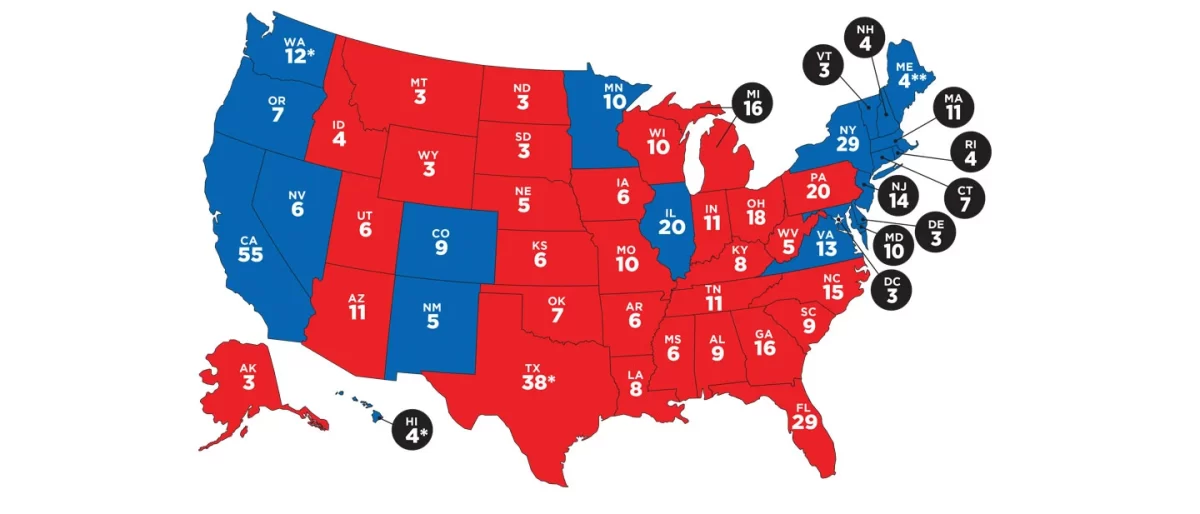The Electoral College, an institution as old as the United States itself, has long been a topic of debate and controversy. This is because it has become increasingly evident that it is an unnecessary and antiquated system that fails to serve the democratic principles upon which this nation was founded.
The Electoral College was conceived by the Founding Fathers as a compromise between those who believed in a direct popular vote and those who favored congressional selection of the president. Under this system, each state is assigned a certain number of electoral votes based on its population, plus two additional electors delegation (Senators and Representatives combined). For example, California has 52 Representatives and 2 Senators, so it has 54 electoral votes.
This allocation method is rooted in concerns about balancing the power between smaller and larger states. However, as the nation has evolved, the original intent of the Electoral College has been lost, and it no longer effectively achieves that balance. It is time to acknowledge that this relic of the past is no longer serving the best interests of our democracy.
While the Electoral College was designed to prevent smaller states from being overshadowed by larger ones, it no longer serves this purpose effectively. It often has the opposite effect, disproportionately amplifying the voices of citizens in sparsely populated states and diminishing the significance of the popular vote.
The United States has grown and changed significantly since the Electoral College was first established. The notion that some citizens’ votes should carry more weight than others due to their geographic location no longer aligns with the democratic ideals of equality and representation.
The 2016 presidential election vividly illustrates the Electoral College’s flaws. According to Statista, Hillary Clinton secured nearly 3 million more votes than Donald Trump in the popular vote. Yet, due to the Electoral College system, Trump was declared the winner. The graphs presented by Statista show Clinton received 65,853,514 votes (48.2%), while Trump received 62,984,828 votes (46.1%)—a clear discrepancy between the popular vote and the Electoral College outcome of Clinton’s 232 votes to Trump’s 306 votes.
This disparity between the popular vote and the Electoral College outcome creates a crisis of legitimacy. It undermines the public’s trust in the electoral process and leads to questions about the fairness of our democracy.
The Electoral College systematically misrepresents the will of the people. To highlight this issue, the statistics by FairVote say it all. They state, “[…]each individual vote in Wyoming counts nearly four times as much in the Electoral College as each individual vote in Texas. This is because Wyoming has three (3) electoral votes for a population of 532,668 citizens (as of 2008 Census Bureau estimates) and Texas has thirty-two (32) electoral votes for a population of almost 25 million. By dividing the population by electoral votes, we can see that Wyoming has one “elector” for every 177,556 people and Texas has one “elector” for about every 715,499.” These statistics show that a single vote in Wyoming carries significantly more weight than a vote in Texas. This disparity undermines the principle of one person, one vote, and renders the presidential election process fundamentally unfair.
This unfairness is not limited to Texas and Wyoming. It affects countless citizens across the nation. The Electoral College distorts the votes of people in many states, large and small, urban and rural. It raises questions about whether every American’s vote truly counts, as it should in a democratic system.
Recent polls and surveys consistently show that a majority of Americans favor replacing the Electoral College with a direct popular vote. According to a poll by Gallop, in September 2020, 61% of Americans support amending the Constitution to replace the Electoral College with a popular vote system.
Public support for the reform is growing, and several states have already taken steps toward this goal by joining the National Popular Vote Interstate Compact, which aims to ensure that the winner of the national popular vote becomes the president. As of August 2023, 15 states and the District of Columbia have joined the NPVIC.
One of the most significant flaws of the Electoral College is the way it distorts presidential campaigns. Candidates often focus their efforts and resources on a select few “battleground states” where the race is close and the outcome is uncertain. These states receive an overwhelming amount of campaign attention, including rallies, television advertisements, and grassroots organizing, while other states are largely ignored.
This “battleground state” mentality creates a situation where the concerns and priorities of citizens in non-battleground states are marginalized. Candidates concentrate on issues that are most relevant to swing voters in those key states, neglecting the border diversity of concerns and interests across the nation. As a result, policy priorities are skewed, and the voices of millions of Americans are drowned out by the disproportionate attention given to a handful of states.
The problems posed by the Electoral College demand a fundamental reevaluation of our electoral system. While abolishing the Electoral College is a crucial first step, it is equally important to consider the alternative solution
One viable option is to adopt a direct popular vote system, where the candidate who secures the majority of the popular vote nationwide becomes the President of the United States. This straightforward approach would ensure that every American’s vote carries equal weight and that the candidate with the broadest national support assumes office.
A direct popular vote system would also eliminate the need for battleground states, allowing candidates to campaign across the country and address the diverse concerns of all citizens. It would encourage a more comprehensive policy agenda, ensuring that the priorities of voters from various regions are heard and considered
The implementation of such a system would require amending the Constitution, which is a significant undertaking. Amending the Constitution is not an easy task, nor should it be. It requires a broad consensus and careful consideration of the implications. However, when it comes to the fundamental principles of our democracy, such as ensuring that every vote is equal and representative of the people’s will, the effort is more than justified.
The Constitution is a living document that should adapt to change. The Electoral College is an outdated system that no longer aligns with the principles of fairness and representative democracy. The 2016 election’s outcome, the statistical disparities in representation, and the growing public support for reform all point to the urgent need for change. It is time for the United States to join the ranks of modern democracies that have already embraced a direct popular vote as the only fair and conclusive way to elect their leaders. Let’s ensure that every American’s vote truly counts, regardless of where they live, and restore faith in the democratic process. It’s time to retire the Electoral College and embrace a more equitable and representative system.








